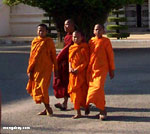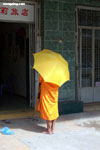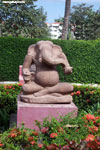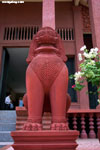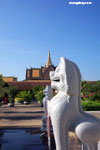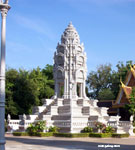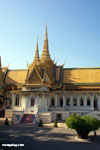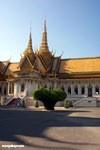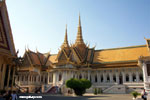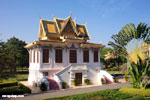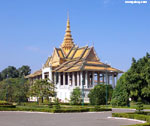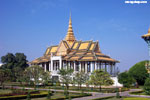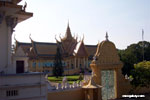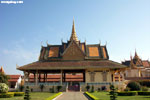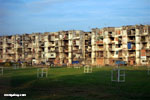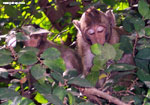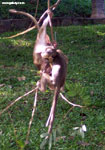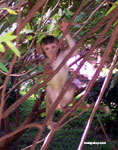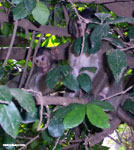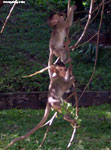
|
CAMBODIA: S-21 | Phnom Penh | Angkor Wat | Bayon | Ta Prohm |
|
Cambodia Pictures
Phnom Pehn All images are the property of Rhett Butler, copyright 2003. Contact me regarding use and reproduction.
Recommended travel guides on Cambodia: 
Phnom Penh - from Wikipedia Phnom Penh is the largest, most populous and capital city of Cambodia. It is also the capital of the Phnom Penh municipality. Once known as the Pearl of Asia in the 1920s, Phnom Penh, along with Siemreap, is a significant global and domestic tourist destination for Cambodia. Phnom Penh is renowned for its traditional Khmer and French influenced architecture, along with it's friendly people. It is also the commercial, political and cultural hubs of Cambodia and is home to 1 million of Cambodia's population of 11.4 million. Naming The city takes its name from the Wat Phnom Daun Penh (known now as just the Wat Phnom or Hill Temple), built in 1373 to house five statues of Buddha on a man made hill 27 meters high. It was named after Daun Penh (Grandma Penh), a wealthy widow. Phnom Penh was also previously known as Krong Chaktomuk (Chaturmukha) meaning "City of Four Faces". This name refers to the junction where the Mekong, Bassac, and Tonle Sap rivers cross to form an "X" where the capital is situated. Krong Chaktomuk is an abbreviation of its ceremonial name given by King Ponhea Yat which was "Krong Chaktomuk Mongkol Sakal Kampuchea Thipadei Sereythor Inthabot Borei Roth Reach Seima Maha Nokor". History Phnom Penh first became the capital of Cambodia after Ponhea Yat, king of the Khmer Empire fled Angkor Thom when it was captured by Siam in 1431. There are stupa behind Wat Phnom that house the remains of Ponhea Yat and the royal family as well as the remaining Buddhist statues from the Angkorean era. It was not until 1866 under the reign of King Norodom I that Phnom Penh became the permanent seat of government, and the Royal Palace (pictured) was built. This marked the beginning of the transformation of what was essentially a village into a great city with the French Colonialists expanding the canal system to control the wetlands, constructing roads and building a port. By the 1920s Phnom Penh was known as the Pearl of Asia and over the next four decades continued to experience growth with the building of a railway to Kompong Som and the Pochentong International Airport. During the Vietnam War, Cambodia, including Phnom Penh, was used as a base by the North Vietnamese Army and the NLF, and thousands of refugees from across the country flooded the city to escape the fighting between their own government troops, the NVA/NLF, the South Vietnamese and its allies and the Khmer Rouge. In 1975 the population was 2,000,000. The city fell to the Khmer Rouge and Democratic Kampuchea on April 17, the Cambodian New Year, and was evacuated by force; its residents being made to labor on rural farms as "new people". Tuol Svay Prey High School was taken over by Pol Pot's forces and was turned into the S-21 prison camp, where Cambodians were detained and tortured. It is now the Tuol Sleng Museum and along with Choeung Ek (The Killing Fields), 15 kilometers away, a memorial to those who were killed by the regime. The Khmer Rouge were driven out of Phnom Penh by the Vietnamese in 1979 and people began to return to the city. A period of reconstruction began, spurred by continuing stability of government, attracting new foreign investment and aid by countries including France, Australia, and Japan. Loans were made from the Asia Development Bank and the World Bank to reinstate a clean water supply, roads and other infrastructure. By 1998, Phnom Penh's population was 862,000. Tourism Chedi of Wat Phnom in Phnom Penh.The main tourist attractions in Phnom Penh include the Royal Palace, the Silver Pagoda, the National Museum, Independence Monument (Khmer: Vimean Akareach), Choeung Ek Genocidal Center, the Toul Sleng Museum of Genocidal Crime, and Wat Phnom. Transport Pochentong International Airport (Phnom Penh) is the largest airport in Cambodia. Nearly all commercial airports in Cambodia is served here. Angkor International Airport (Siemreap) is the next largest and mainly serves tourists to Angkor Wat. |
what's new | rainforests | tropical fish | for kids | search | about | copyright & use | contact |
Copyright Rhett Butler 1994-2025 Pictures were taken by Rhett A. Butler, copyright 1994-2025. While these photos are the property of mongabay.com, it may be permissible to use them for non-commercial purposes (like powerpoint presentations and school projects), provided that the images are not altered in any form. Please read this for more details. If you are interested in using an image in a publication please contact me. Mongabay.com is a free resource. |




